
Adrian Lindon, managing director, Design and Engineering at Atkins – Middle East & Africa, talks about sustainability and his current projects
What is the EDPM business focus within the SNC-Lavalin Group and which sectors do you cover in the GCC?
Atkins, a member of the SNC-Lavalin Group, is one of the world’s most respected engineering, design and project management (EDPM) consultancies. Within the design and engineering business, our focus is around the For Atkins, a member of the SNC-Lavalin Group, our built environment sector’ focus is primarily around master planning, hospitality, residential, and mixed-use developments, as well as commercial and cultural projects such as the Dubai Opera House, and Bahrain World Trade Centre. Under our civil, infrastructure and transportation sector, we focus on metro projects such as the Dubai and Riyadh Metros, International Airports such as King Abdulaziz International Airport (KAIA) in Jeddah, and major civil/ infrastructure projects in KSA.
Could you describe your role in the latest Dubai Festival City marine station project?
This project was an international concept design competition run by Roads and Transport Authority (RTA) in 2017. We were delighted to be the winners of this competition and incorporate innovative solutions to meet the project-specific demands by RTA. As for this project, the design that we created was aimed to be self-sufficient in terms of energy generation, to utilise 3D printing and to be modular to allow flexibility in rolling out the modules at different locations and with different scales around the canal. The canopies housed photovoltaics cells that both provided shade and generated energy for the facility. The sustainable design aimed at generating its own power and hence reduces operational cost and reflects RTA’s commitment to the environment. The station was successfully launched in May 2019.

How is your business focussing on sustainability?
We increasingly think about our performance along the three dimensions or triple bottom line of sustainability—economic, social, and environmental. We approach all our projects with a ‘doing more with less’ attitude, and we particularly look at how we can reduce the operational costs and, therefore, the environmental impact once the asset is operational. We then look at digital asset management allowing clients to manage their assets in the most efficient way possible. In the built environment, our plans and designs aesthetically and functionally blend human and natural elements, while promoting resource conservation and cost efficiency for projects ranging from full-scale communities to individual buildings.
You have worked on various transportation projects all over the world. What are the unique challenges you face in the GCC countries when designing such commissions? Draw the differences.
There is a great opportunity to introduce industry best practices, such as developing design guidelines for transportation projects and to bring in global engineering expertise with local knowledge to help provide greater advantage and agility in projects. The Dubai Metro is a great example where Atkins supported the JV contractor, Japan Turkey Metro Joint Venture (JTMJV), by providing full multidisciplinary design and management of the civil works on the project. It was a great challenge to tackle the project in a carbon-critical way. Our approach resulted in less aluminium, glass, and more insulation than the original designs. How do you add value to your projects? When we talk about value engineering with our clients, we drive a focus not just on saving money but also on reducing operational costs, improving mobility, unlocking growth, and improving the quality of the environment for the user. To summarise, we focus on well-being and reducing the impact on the environment from a vision of sustainable lifespan.

How digital transformation in design and engineering is affecting your projects?
Our business is becoming more and more about data and how we manage this data in the way we operate, the way we design, and the way we behave as a business. We have been using BIM on our projects for well over a decade now but developments in 4D all the way to 7D are starting to impact on the way we design our projects. Our digital asset management team is focussed on building our capability and solutions for clients in asset investment planning, asset performance management, and asset management systems. Share some current projects you’re working on? We are heavily involved in some of Saudi Arabia’s major projects such as Public Investment Fund (PIF) projects including the design and site operations on several packages on King Abdullah Financial District in Riyadh and the Diriyah Gate masterplan. In the UAE, we have several exciting projects including Marsa Al Arab in Dubai, Saadiyat Grove in Abu Dhabi, and the extension to the Dubai Metro into the Expo site, Route2020.








